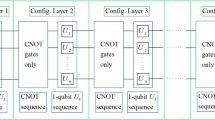Abstract
Discrete finite-valued functions are increasingly important in applications involving automation and control. In particular, it is evident that industry is focusing on “Systems-on-a-Chip” (SoC) where the integration of analog (infinite-valued) and digital (binary-valued) circuits must co-exist. As designers struggle with these interfacing issues, it is natural to consider the intermediate circuits that can be modeled as multi-valued, discrete logic-level circuits. This viewpoint is not unprecedented as such principles have been used for at least the past twenty years in telecommunications protocols. If an analogous approach is considered in control systems implemented in “Integrated Circuit” (IC) designs, it is proposed that spectral analysis may provide an important role and efficient methods for computing such mixed-radix function spectra are described here. These methods are formulated as transformations of word-level decision diagrams representing the underlying arithmetic expressions and can be implemented as graph traversal algorithms. The theoretical foundation of the spectral transform of a mixed-radix function is presented and the equivalence of the resulting spectrum and the spectrum of a Cayley graph is shown.
Similar content being viewed by others
REFERENCES
Bernasconi, A. and Codenotti, B., Spectral Analysis of Boolean Functions as a Graph Eigenvalue Problem, IEEE Trans. Comp., 1999, no. 48, pp. 345–351.
Thornton, M.A., Miller, D.M., and Townsend, W., Chrestenson Spectrum Computation Using Cayley Color Graphs, Int. Symp. on Multiple-Valued Logic, 2002.
Chrestenson., H.E., A Class of Generalized Walsh Functions, Pacific J. Math., 1955, no. 5, pp. 17–31.
Vilenkin, N.Ya., Concerning a Class of Complete Orthogonal Systems, Dokl. Akad. Nauk SSSR, Ser. Math., 1947, no. 11.
Babai, L., Spectra of Cayley Graphs, J. Combinatorial Theory, Series B, 1979, no. 27, pp. 180–189.
Head, G.A., Lukoshkova, E.V., Burke, S.L., Malpas, S.C., Lambert, E.A., and Janssen, B.J.A., Comparing Spectral and Invasive Estimates of Baroreflex Gain, IEEE Eng. Medicine Biology Magaz., 2001, no. 20(2), pp. 43–52.
Wirth, F., Dynamics of Time-Varying Discrete-Time Linear Systems: Spectral Theory and the Projected System, SIAM J. Control Optimiz., 1998, no. 36(2), pp. 447–487.
Karpovsky, M.G., Finite Orthogonal Series in the Design of Digital Devices, New York: Wiley, 1976.
Pontryagin, L.S., Nepreryvnye Gruppy (Continuous Groups), Moscow: Ghostehizdat, 1954.
Garaev, M.U. and Faradzhev, R.G., On an Analog of Fourier Expansion over Galois Fields and Its Applications to Problems of Generalized Sequential Machines, Izv. Akad. Nauk Azerb. SSR, Ser. Fiz.-Techn. Mat. Nauk, 1968, no. 6, pp. 69–75.
Maslen, D.K. and Rockmore, D.N., Generalized FFTs-A Survey of Some Recent Results, DIMACS Workshop in Groups and Computation, 1995, pp. 183–238.
Ahmed, N. and Rao, K.R., Orthogonal Transforms for Digital Signal Processing, New York: Springer-Verlag, 1975.
Dummit, D.S. and Foote, R.M., Abstract Algebra, Upper Saddle River: Prentice Hall, 1999.
Graham, A., Kronecker Products and Matrix Calculus with Applications, New York: Wiley, 1981.
Cooley, J.W. and Tukey, J.W., An Algorithm for the Machine Calculation of Complex Fourier Series, Math. Computation, 1965, no. 19, pp. 297–301.
Shanks, J.L., Computation of the Fast Walsh-Fourier Transform, IEEE Trans. Comp., 1969, no. 18, pp. 457–459.
Mason, S.J. and Zimmermann, H.J., Electronic Circuits, Signals, and Systems, Massachusetts: Massachusetts Inst. Techn., 1960.
Stankovi?, R.S., Sasao, T., and Moraga, C., Spectral Transforms Decision Diagrams, in Representation of Discrete Functions, Sasao, T. and Fujita, M., Eds., NewY ork: Kluwer, 1996.
Thornton, M.A., Drechsler, R., and Miller, D.M., Spectral Techniques in VLSI CAD, NewYork: Kluwer, 2001.
Clausen, M., Fast Generalized Fourier Transforms, Theor. Computer Sci., 1989, no. 67, pp. 55–63.
Maslen, D.K., The Efficient Computation of Fourier Transforms on the Symmetric Group, Math. Comp., 1998, no. 67(223), pp. 1121-1147.
Miller, D.M., Graph Algorithms for the Manipulation of Boolean Functions and Their Spectra, in Congressus Numerantium, Winnipeg: Utilitas Mathematica, 1987, pp. 177–199.
Miller, D.M., Spectral Transformations of Multiple-Valued Decision Diagrams, Int. Symp. on Multiple-Valued Logic, 1994, pp. 89–96.
Thornton, M.A. and Drechsler, R., Spectral Decision Diagrams Using Graph Transformations, Design, Automation, and Test in Europe, 2001, pp. 713–717.
Bryant, R.E., Graph-Based Algorithms for Boolean Function Manipulation, IEEE Trans. Comp., 1986, no. 35 (8), pp. 677–691.
Author information
Authors and Affiliations
Rights and permissions
About this article
Cite this article
Thornton, M.A. Mixed-radix MVL Function Spectral and Decision Diagram Representation. Automation and Remote Control 65, 1007–1017 (2004). https://doi.org/10.1023/B:AURC.0000030910.23047.2d
Issue Date:
DOI: https://doi.org/10.1023/B:AURC.0000030910.23047.2d




